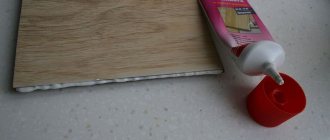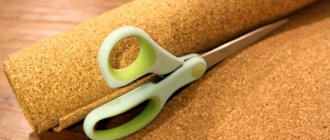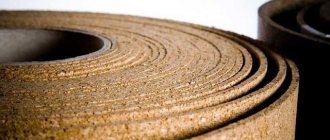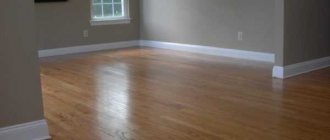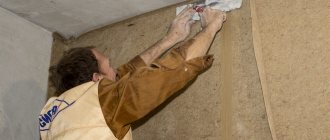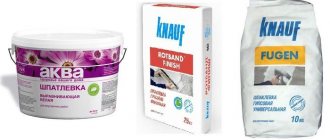Description of cork sealants
These sealing products are based on fine cork chips, which constitute about 90-95 percent of the total volume. In addition, the substance contains specialized polymer substances, water, fillers and binders that make cork sealants of the required thickness and texture. Depending on the quality of the cork, the quality of the sealing composition will be worse or better. The best raw materials are obtained from oak bark, a type of cork tree. Sealants based on such oak bark have a significantly higher cost than substitutes made from any other type of wood.
When cork sealants cure, they acquire the following characteristics:
- small mass;
- excellent elasticity and sufficient resilience;
- low heat conductivity;
- environmental cleanliness and safety;
- resistance to chemicals and physical and mechanical influences.
Depending on the type of binders present in the sealant, it will have certain characteristics. Typically, polyacrylate glue is used as binding components, which is a water-soluble mixture that does not release harmful or toxic substances during hardening. Polyacrylates increase the adhesion (adhesion) rate of cork sealant with various types of materials, such as, for example, tiles, laminate, parquet and others. Polyacrylates combine well with cork coatings and eliminate certain disadvantages of these seams and surfaces, for example, poor resistance to ultraviolet rays, acidic environments, and low hygroscopicity.
General information
Coating properties
Floors are exposed to pressure from walking and furniture, therefore, in order for coatings to serve for a long time, it is necessary to take into account their purpose in different rooms of an apartment or private house.
Each room of the apartment: room, corridor or kitchen requires the installation of its own floor covering. So, in rooms, the main thing for flooring is comfort and coziness; in the kitchen, the floors are often washed and exposed to chemicals, so it is better to lay them with ceramic tiles. In the corridor, flooring must be durable.
Floors made of different materials must be joined together. For a smooth transition from one floor covering to another, thresholds made of rubber or other elastic material are used. But these materials do not justify themselves; over time, they become rigid and lose elasticity, disrupting the harmony of the interior.
A way out of this situation may be a joining profile, which is popularly called a cork compensator or cork separator. Its installation will help compensate for the expansion of the floor, relieve tension between different materials and make the seam between them invisible. Today we will tell you what a cork expansion joint is, what it comes in and how to install it at the junction of different floor coverings.
What is a cork compensator
A cork expansion joint is a strip of crushed cork tree bark 7 mm thick, 15 mm high and 900 mm long. The end of the strip is coated with special paint and water-based polyurethane varnish. The color range of cork expansion joints is varied; a wide range of shades allows you to choose the desired color of the joint of floor coverings.
The cork expansion joint makes it possible to fill the seam between two floor coverings, making the difference between them less noticeable and not noticeable. A contrasting cork will emphasize the dividing line of rooms or zones in rooms, giving the apartment an impressive, stylish look.
In addition, the cork expansion joint, filling the gap between floor coverings, prevents the destruction of materials and protects them from mechanical impacts. The cork compensator can be used both in one room and in different ones.
Why is it necessary to join floor coverings in one room?
Recently, zoning of rooms has become widespread. Zoning is done both with the help of partitions, curtains, and by using several floor coverings in one room, for example, tiles and laminate. The room can be divided into dining and kitchen. The dining area will be laid with laminate, and the kitchen with tiles. This design solution using a contrasting cork expansion joint will divide the room into zones.
Designers propose to visually increase the space of the room through the use of laminate and tiles in the hallway. A cork expansion joint will highlight the features of the apartment’s interior.
The combination of two floor coverings in one room is practical. So, for example, you can lay ceramic tiles at the front door, and then laminate throughout the entire corridor. A cork expansion joint will help make the joint between them invisible.
Using two floorings in one room will save you money because tile is much more expensive than laminate. A stylish solution will amaze your friends and make your interior creative and fashionable.
Advantages of a cork compensator
The cork compensator has a number of advantages:
- Cork is a natural, environmentally friendly material that does not emit harmful substances. Natural components used to make cork expansion joints make it possible to use it in apartment buildings, cottages, and public buildings. When the material burns, chlorine, phenol and other hazardous substances are not released. To prevent the cork from burning, it is treated with a special substance. Naturalness and environmental friendliness make the material reliable and safe. Disposal occurs naturally.
- Thanks to its pores in the granules, cork has low thermal conductivity, helping to retain heat in the apartment.
- The cork compensator does not allow loud sounds to pass through, dampening them. It can absorb noise with a power of 27 dB
- In addition, cork is resistant to high and low temperatures. At negative temperatures it does not lose its properties.
- The water resistance of the cork will allow you not to worry about it; it will not deteriorate even in high humidity.
- One of the important properties of a cork compensator is to reduce the level of radioactive radiation.
- Cork expansion joint is a natural antiseptic that protects floor coverings from insects, rodents, rotting, and mold. Therefore, there is no need to fear that ceramic tiles, parquet, laminate in contact with the cork expansion joint will begin to deteriorate under the influence of harmful microorganisms.
- The compensator strip is not exposed to ultraviolet radiation, does not transmit static electricity and does not accumulate it.
- The variety of colors of the compensator strip helps to choose the same tone of the material in order to veil the sharp transition from one floor covering to another. The cork expansion joint can be easily painted in any color using light-resistant tints, which makes it possible to obtain a shade of any intensity.
- The cork compensator is easy to install and simply dismantled. Any person who is far from construction and does not have professional flooring skills can handle the installation of the material.
- Cork expansion joint highlights the best aspects of floor coverings, giving them style and attractiveness.
- The cork expansion joint will last a long time: it does not sag, does not get trampled, quickly contracts and returns to its shape, because the material is elastic and elastic and is not subject to hardening.
- The material is universal because it is used for various types of flooring: laminate, ceramic tiles, parquet.
Main advantages
Cork sealants for joints and seams are also called liquid cork; today it is a very popular and in-demand material in the field of repair and construction work. Liquid cork has many advantages, the most important of which is complete safety for human health, so cork sealants can be safely used inside residential premises, including kindergartens, hospitals, and other institutions.
The main component of cork sealants is a biodegradable, completely natural substance, and all other components contained in the composition are also safe for humans and environmentally friendly. There are no organic solvents in such products; sealants are diluted with plain water. Here is a list of the main advantages of liquid cork used for joints of tiles, laminate and parquet:
- excellent thermal insulation characteristics;
- after applying and drying the composition, the joints of the laminate and tiles become impenetrable;
- sound insulation in the room increases;
- long service life reaching 10 years;
- high strength index;
- resistance to temperature changes and high humidity;
- can be applied to deformable surfaces and interpanel joints, since the product is elastic;
- you can process joints and seams of various types of materials, the sealant has a high adhesion rate to different surfaces;
- after many years, liquid cork does not shrink, retains its original shape and remains visually attractive.
Due to these advantages, cork sealing products are used quite often today.
Advantages of the product
Sealants based on cork crumbs (liquid cork) are very popular in construction and repair. They boast a number of advantages, the main one of which is safety for humans, the ability to be used indoors, including in children's institutions and hospitals. The basis of any sealant is a biodegradable natural material; all additional components are also environmentally friendly. The products are diluted with water and do not contain organic solvents.
Other advantages of cork sealant:
- excellent thermal insulation properties,
- ensuring the tightness of joints,
- improving the soundproofing of the room,
- strength, long service life (up to 10 years),
- resistance to humidity, temperature changes,
- Can be used on deformable substrates due to its elasticity,
- Suitable for different types of materials, excellent adhesion to them,
- no shrinkage over time, maintaining shape and original appearance.
Cork sealant has good thermal insulation and does not shrink
Scope of use
High-quality liquid cork is suitable for sealing any types of joints, seams, and problematic areas found on any floor covering or wall decoration. Cork sealants are excellent for joints between tiles and parquet, laminate, and cork flooring. This material can be used in any place where it is necessary to create a noise-insulating, insulating and sealing layer in the room. Here are the main uses of liquid stopper:
- sealing seams during repair or installation of panel buildings;
- sealing joints and seams between panels in different buildings;
- creation of expansion joints;
- sealing cracks when installing window and door structures;
- creation of sealing contours;
- sealing seams and joints in buildings made of wood and SIP panels;
- formation of gaskets in various mobile objects in order to reduce vibrations;
- creation of high-quality sound insulation of floors between floors and partitions between rooms.
The scope of use of cork sealants for joints and seams is very extensive, since the material can be applied not only to wood, parquet, laminate and cork, but also to PVC, metal, ceramic, glass, and concrete surfaces. These sealing products will not damage even the most delicate materials.
Leading compensator manufacturers
Although compensating elements have appeared recently, there are already quite a few such products from various manufacturers on the domestic market, among which the following are more reliable:
| Material name | Where is it produced? | distinctive properties | Price in rubles |
| Cork compensator | Egen (Poland) | Strips 5–10 mm thick of fine-grained compressed cork, uncoated | 100–150 for 1 product |
| Cork sheet | Amorim (Portugal) | Sheets of different cuts made from coarse and fine-grained cork chips | 1,000 for 1 sheet |
| Liquid cork expansion joint | Isocork, Nanocorc (Russia), Bostic (France) | Requires quick work with material | 160–200 per 0.5 l |
When choosing expansion joints, they choose reliable manufacturers whose products have earned good reviews and are distinguished by high wear-resistant qualities.
Application for thermal protection
When insulating houses and other structures, sealing seams is a mandatory procedure. Creating thermal insulation of joints, seams and various surfaces protects against the occurrence of cold bridges, which could penetrate through hidden places and areas. Thanks to the reliable and strong adhesion of the cork sealant to the base, a monolithic, durable joint is formed.
The sealing agents have optimal fluidity and plasticity, due to which they penetrate even the smallest cracks, joints and defects, are very easy to apply and are simply smoothed out with a regular spatula. When the composition is used to seal joints of laminate or other finishing materials, it perfectly levels out any unevenness and roughness and makes the surface visually attractive. After hardening, the product can be tinted or painted.
How to choose liquid cork compensator for tiles and laminate
In order for the joint to be smooth and beautiful, it is best to use a cork in half-liter film tubes for a syringe gun. In addition, transparent film allows you to see the real color of the material, and it may differ even from the same manufacturer.
It is more convenient to work with plastic boxes if the joint width is no more than 6 mm. There are a limited number of colors of liquid compensator available for sale, so you need to decide on the shades of the cork seal in advance.
High quality mixture for sealing joints on laminate flooring
Cork silicone from French is considered to be of the highest quality; Russian brands “Isocork” and “Nanocork” will cost a little less.
Application for construction projects
All reinforced concrete structures and SIP panels have one drawback - under the influence of seasonal changes in temperature and humidity, they are subject to linear fluctuations. Not every sealant is suitable for sealing joints in reinforced concrete structures, since the compounds break down quickly enough and do not have suitable elasticity.
Using polyurethane foam as a sealing agent does not give a positive result, since the foam cracks over time, turns yellow, and after a few years loses its characteristics. Cork sealing compounds are an excellent replacement for polyurethane foam and any specialized mastics. This product is suitable for filling all types of seams, including locking ones, effectively eliminates cold bridges, seals seams and areas adjacent to frame objects. Thanks to these compounds, you can seal joints and seams at home with your own hands; this possibility is relevant for any panel structures.
Other questions on this topic
How to prepare a foam concrete floor for renovation? We bought an apartment in a new building, the floor is covered with some kind of screed (neighbors say it’s foam concrete), the material is like cement, but it generates dust all the time... if you sweep it, it seems you can sweep it all into dust... We asked the residents , what they did with the floors, they said... The color of the floor in the interior is Studio 19.70. The side is not sunny.
I want light wallpaper, white gloss ceiling. All the furniture is wenge-bleached oak, the doors are wenge. What color is best to lay linoleum. I really don’t want it dark, hello everyone! Is it worth using gypsum fiber board for floors instead of screed? We bought a new building. There is no screed or plaster.
The question is what to do with the floors? GVL? Screed?
Or something else? Tell me, please! Hello. What kind of floor to make in “Stalinka”: scraping old boards, laminate onto boards, laminate onto screed? The problem is that upon opening one board, a floor slab with stiffening ribs about 10 mm high was discovered, and after completely dismantling the old floor, leveling the screed and laying the laminate will be costly.Which of the 3 above options is optimal...Which coating is best to choose for the floor of a school gym?Renovation is planned in the school gym.
What flooring material is best to choose, given the fact that the room is constantly in use? We want something bright, unusual, functional and not very expensive. Thank you)
Combinations of seemingly incompatible materials look stylish and unusual if done correctly. What kind of joint can there be between parquet and tiles without a threshold, what are the features of the joint with a threshold, and how to carry out installation correctly in both cases? More on this below.
There are different ways to join parquet floors and tiles
Application for floor
Liquid parquet cork is excellent for sealing during installation of any floor coverings, including linoleum. Cork efficiently seals the joints formed between the flooring material and the walls, while the sealed seams do not interfere with linear vibrations, while protecting the room from the penetration of rodents, insects and blowing. If mineral wool is laid under the flooring material, the sealing plug prevents the smallest fibers from entering the room.
Cork sealants make it possible to lay combined floor coverings, such as tiles, laminate, or linoleum. A sealing compound is applied to the joints of these materials, making the seams attractive and protecting them from moisture, dirt, and deformation. These products are made in different colors, so you can accurately match the color to the floor covering.
Why do you need to join floor coverings?
When designing modern interiors, zoning of rooms is widely used. It is often created by installing several different floor coverings in one room. For example, the kitchen can be divided into two zones: for cooking and dining. It is better to lay the first one with tiles, the second one with laminate.
Also, with the help of tile and laminate coverings laid within the room, it is possible to visually increase its dimensions. And the successful use of a cork expansion joint will favorably emphasize the features of the room design.
Use for soundproofing
Cork sealing products are often used for gluing soundproofing sheets and boards, as well as for sealing seams between these panels. The material significantly reduces the noise level, and when applied to a subfloor, it eliminates the squeaks of wooden boards. The product is used for soundproofing machines, installing certain blocks and components, and also makes it possible to reduce vibration of generators, machine tools, and other electrical equipment.
Life on the move
Photo by A. Elistratov Particular care should be taken when selecting and installing thresholds on natural wood flooring (parquet, parquet and solid boards). The fact is that wood, unlike many other materials, reacts to changes in the environment even after it has been cut down, dried and turned into an element of interior design.
In winter, during the heating season, the humidity in the apartment decreases noticeably, and the wooden floor planks gradually dry out and decrease in size. With the arrival of spring, summer and autumn, they respectively gain moisture and increase somewhat. Thus, throughout its life, a wooden floor never stops moving.
When laying natural wood flooring near walls, in transition areas from room to room, as well as in areas adjacent to columns, pipes or other floor coverings, qualified specialists must leave so-called compensation gaps.
Without them, wooden planks, the size of which, albeit slightly, increase, simply have nowhere to go. The coating begins to put pressure on the obstacle with enormous force. According to experts, in places where parquet tightly adjoins ceramic tiles, it often chips off its edge! Another scenario is also possible: poorly secured planks sometimes come off the base.
Everything we said about the properties of wooden floors also applies to laminate flooring. Although the basis of its slats is not wood, but fibreboard, when the humidity in the room increases, it also swells a little.
There is one more nuance: floors laid in a “floating” way, that is, not attached to the base (parquet boards, laminate), move much more than parquet that is rigidly glued to the base. Therefore, the sufficient size of the compensation gap for piece parquet is 10-15mm, and for “floating” floors - 15-20mm.
Compensation gaps near walls are traditionally covered with skirting boards. When moving from room to room or at the junction of different floor coverings, thresholds are used, which are considered an integral element of a well-made floor. The main task of the master is to remember to take into account the size of the fastening when determining the width of the expansion joint.
Terms of use
In order for cork sealants to work as efficiently as possible and last a long time, it is important to follow certain rules and recommendations for applying the compounds. Here is a general scheme for using sealing agents when installing various materials:
- first of all, the surface is cleaned of any contaminants, for example, grease stains, debris, dirt, dust. For cleaning, use a vacuum cleaner, detergents, water and degreasing solvents;
- prepare tools - construction gun, sponge, rags, spatula;
- the edges of the seams are sealed with masking tape;
- Using a gun, the composition is applied, which is distributed by a nozzle. A spatula is used to smooth out the seams; it is important to moisten it with water from time to time;
- use a sponge or rag to immediately remove excess substance;
- wait 24-48 hours for the product to dry completely. The drying period depends on the product manufacturer, as well as on temperature and humidity conditions.
Liquid cork must be applied at air temperatures above +5 degrees. Until the product is completely dry, it is important to protect it from exposure to precipitation if the substance was applied outdoors. When the composition is completely dry, its excess is carefully trimmed using a sharp knife.
Installation process
Installation of a solid cork expansion joint for laminate flooring must be done in the following order:
- Clean the joint between the floor coverings to be laid so that it is uniform along its entire length.
- The seal should not rise above the floor by more than 1 mm. Otherwise, it needs to be carefully trimmed.
- Place glue in a gun and apply it to the edges of the laminate along the seam.
- Place the cork expansion joint at a slight angle and glue the end.
- Insert a container of acrylic sealant into the gun.
- Lift the upper part of the installed element, bend it, fill it with a sealing agent, and press it.
- Using a damp sponge, remove excess adhesive.
- Wipe the threshold with a clean rag.
- Lay the tiles on the appropriate level, using special glue.
Cork products are quite flexible, they can be used for arranging curved joints.
It is important to join tiles and laminate using a cork expansion joint according to technology Source i.ytimg.com
Facade and interior works
These sealing substances are suitable for application to the facades of houses; thanks to these products, vibration and noise are reduced, heat losses are minimized, and the walls acquire a beautiful and natural appearance. Also, liquid cork is applied to the internal surfaces of walls when gluing cork wallpaper and other wood-like finishes. The composition is applied using a gun with a thin tip installed, since during interior decoration the joints of the two materials are very narrow.
How to make a cork insert between tiles and laminate
The material dries quickly, so basic preparatory work must be completed long before laying the silicone plug in the joint between two floor coverings:
- Using a hand router, the edge of the lamella is aligned;
- The cut shavings and sawdust are blown dry with a vacuum cleaner;
- The inner surface is treated with a primer, which facilitates the adhesion of the sealant to the cement base.
The material is applied using a syringe; it is not possible to seal the joint quickly and beautifully with a spatula or other tool. The liquid sealant is laid, as they say, “heaped”, so that it protrudes 2-3 mm above the level of the lamella. After the cushioning layer has set, soapy water or oil is applied to its surface and the excess is cut off with a sharp blade of a stationery knife.
Cutting the top layer requires certain skills, so before laying it will be useful to first practice on scraps of lamellas.
For parquet
During the installation of parquet boards, there is a need to seal the seams between the walls and the parquet. Thanks to the sealing agent, this job can be done very easily and quickly. Liquid cork is elastic, it will contract and expand along with the parquet, and is suitable for sealing cracks of any size.
And if defects such as chips and cracks appear on old parquet boards, then cork can be used to repair these damages. In addition, the sealant is used to eliminate the squeaks of this coating.
Purpose
Often, cork expansion joints are used at the junction of parquet with other materials (tiles, linoleum, marble, etc.). Due to the fact that parquet tends to shrink or expand under the influence of external factors, it cannot be laid closely to other material. A tight connection will lead to swelling of the surface, creaking and cracking of the parquet. To avoid such troubles, a cork threshold is used for the connection.
The device is a 10 cm wide strip made from crushed cork tree bark. Thanks to its properties, it can be compressed many times and return to its original state under the influence of the movement of a parquet floor or laminate.
The compensator can also act as a decorative element. Thus, light-colored cork looks beautiful against the background of dark materials. A cork expansion joint can act as a decorative border, which requires a threshold of the same width as the parquet board.
Common Mistakes
Beginners in the field of repair and finishing work quite often make some mistakes when applying liquid cork. One of the most common mistakes is not thoroughly cleaning the surface first and ignoring degreasing of the material. As a result, the adhesion rate of the sealing agent to surfaces is significantly reduced.
Another mistake is untimely removal of excess substance. It is necessary to remove sealant that gets on nearby surfaces immediately, and not leave this work for later. Once the composition dries, it is quite difficult to clean it; in addition, removing dried sealant can damage both the finished seam and the surfaces located nearby.
It is a mistake to think that the applied composition needs to be leveled along the base located above, and not on what is located a level below. If you level the product at a high level, the seam will look unsightly and the product will not fit tightly. Another mistake is to use liquid cork to secure carpeting and to seal joints between carpet and other surfaces.
Using cork sealants strictly according to the instructions, and applying the product only to those materials that are approved by the manufacturer, you will definitely be able to properly seal any seams and joints.
Materials
The market offers wooden, metal, laminated and plastic products, the variety of which will undoubtedly allow you to achieve an ideal combination with the chosen floor finishing option.
Wooden
Solid wood accessories look most natural on a natural wood floor. They can be matched to the coating material and form a single whole with it. The width of the products, regardless of the material from which they are made, is most often 20-60 mm. The length, according to manufacturers, starts with the standard width of a doorway with one leaf. Market research has shown that the size range of lengths of floor accessories for Polish manufacturers starts from 0.8 m, and for German ones - from 0.9 m. You can find products with a length of 0.93 everywhere; 1; 1.35; 1.8; 2; 2.1; 2.4; 2.7 m. Plastic products reach 3 and even 6 m.
Cork instead of baseboard
Modern design dictates that we be extraordinary, forget about ordinary rules and add innovations to our reality. Today I will not talk about how a cork expansion joint installed instead of the usual baseboard is beautiful in the interior, but I will tell you how it is done in practice. You decide for yourself whether you need this.
What is required for this? But we need parquet, a cork expansion joint and a straight guide plane.
Parquet
Due to the fact that the color of the cork oak bark is already determined by nature, the choice of parquet in combination with a cork expansion joint is possible in two variations - to match the color of the cork itself, for example, oak, walnut. Or in contrast to the expansion joint, allowing you to emphasize the flatness of the parquet by edging it.
Compensator
For this work, manufacturers present two options for cork expansion joints on the parquet market: 10x15, 10x22.
Vertical plane
It must be a wall. And you don’t necessarily need a wall at all to properly install a cork expansion joint - it could just be ceramic tiles, porcelain stoneware, marble or stone. In places where there is no vertical plane, but there is a need for a compensator, a building level or some kind of rail can be useful as a stop for stopping in a straight line.
Working conditions
Parquet or solid boards must be laid with a gap of less than 10 mm to the wall. This is necessary to ensure that the cork compensator is installed as efficiently as possible. Where the cork expansion joint is installed, the wall must be flat and perpendicular
to the plane of the wooden floor covering.
You can edge the parquet using a special router adjusted to the width of the expansion joint. It should be taken into account that the router will not be able to cut the parquet to the very extreme point of the corner of the room. And already during installation, it is necessary to cut the parquet rivets “manually” in places inaccessible to the router.
Installation
The compensator is installed after the place for it is cleared of wood residues, shavings and dust. Nothing complicated - you should apply glue (or liquid nails) to one side adjacent to the wood and press the expansion joint into the resulting groove.
After some time, during which the parquet glue dries, the entire plane of the wooden floor covering can be sanded together with the cork expansion joint using parquet equipment. A cork expansion joint whose height exceeds the plane by more than 2 mm should first be cut off manually with a wallpaper knife.
Cork is a great material for parquet work. It can be sanded, cut, it can be easily painted with tinting compounds and varnished. But the most important thing is that it fills the space between the wall and the parquet without compromising the technical characteristics, and at the same time it looks quite stylish.
PS The above method is applicable for parquet work with wooden floor coverings (both screwed and glued), but not for floor coverings installed in a floating manner. I consider everything else a money scam with the ensuing problems.
Dear reader, if you liked the material, like it (it’s here on the left), the topic is familiar - subscribe to the channel, and if there is an interesting story about parquet problems, don’t forget to share it in the comments. This will be our “interest” group.
Source
What is liquid plug
Liquid, also known as sprayed cork, is a universal finishing material consisting of cork wood chips, fraction 0.5-1.0 mm, a polymer binder with modifying additives and water. In fact, it is a good example of using production waste, since the main component is obtained in the process of manufacturing various cork products. The Spaniards figured out how to turn waste into income; the first liquid traffic jam appeared in this country at the beginning of the 2000s. Domestic manufacturers offered an alternative to imports around 2011.
The material is a homogeneous mass, which, after hardening, forms a moisture-resistant, vapor-permeable, elastic coating on the surface, visually reminiscent of pebble plaster.
Due to the common base component - cork chips, products of various brands have similar basic characteristics:
- highly decorative – interesting texture, visually reminiscent of a cement “coat”, wide range of colors;
- high adhesion to various substrates - concrete, brick, wood, metal, gypsum plasterboard, DSP, GSP, OSB, chipboard, PVC, PPS, ceramic tiles, glass, cement and gypsum plaster, etc.
- high elasticity – withstands movements of the base without cracking (tension and elongation of about 33%);
- vapor permeability - due to the porous structure of the cork itself and the ability of the polymer binder to allow air to pass through (up to 75%);
- moisture resistance - allows steam to pass through without conducting water into the inner layers of the base.
In addition, all manufacturers position their coating as a heat-insulating and sound-proof material. Yes, cork has similar properties, but it all depends on the thickness of the layer. On average, it is recommended to spray 4 mm onto the facade in several approaches; in terms of thermal conductivity they will be equal to 4 mm PPS. Naturally, there is no need to talk about complete insulation in such a situation. However, thanks to the impenetrable cork covering without cold bridges, the room will definitely become more comfortable.
As for sound insulation, again, it all depends on the layer to have a real effect, the basic 4 mm is clearly not enough, and applying more is impractical. Sprayed cork plaster is a real alternative to curtain-mounted ventilated facades and wet facades, but if it is necessary to increase heat-saving parameters, then it must be applied on top of thermal insulation materials.
That is, it is a finishing protective and decorative coating, but it cannot completely replace insulation, like a sound insulator.
As for durability, the test of time has not yet passed, due to the “youth” of the technology as such and the relatively short period of use in our climatic conditions. But based on indirect factors, it can be assumed that the 10-15 years of service claimed by manufacturers are quite realistic.
Kotiara82FORUMHOUSE Member
Liquid cork is based on acrylic and cork oak chips. Acrylic has been around for a long time in our area; primers and water-based emulsions are made from it, added to adhesives, etc. And the greater the proportion of acrylic in the composition of these products, the higher their quality. Acrylic has a shelf life of about 10-15 years, and the cork is also quite durable, especially when coated with this same acrylic. Everything else is modifiers that improve the original properties. So here you need to dance from acrylic. As for practice - pieces of coated SIP lay on the street in the rain, sun, snow for 2.5 years - of course, they got dirty, they were lying on the ground, but no significant changes were visible.
